Are you in the market for a new SSD and looking to upgrade to PCIe Gen 5.0? You’re not alone. Many tech enthusiasts are eagerly anticipating the release of these next-gen SSDs, which promise faster speeds and improved performance over their PCIe Gen 4.0 counterparts. However, the release of these SSDs has been delayed, leaving consumers wondering when they can expect to see them on store shelves. Brands like Kioxia, Corsair, Apacer, and TEAMGROUP have all made exciting announcements about their upcoming PCIe Gen 5.0 SSDs, but availability is not expected until Q2 of 2023. In this article, we’ll explore the latest specs and potential release dates for these highly anticipated SSDs.
What is in common in all these SSD? Phison controller.
The Phison E26 is a solid-state drive (SSD) controller that supports the PCIe Gen5 interface. It is designed for high-end consumer and enterprise applications and offers high-speed data transfer rates and low power consumption. The controller supports up to 8 NAND channels and can support up to 8TB of storage capacity. It features LDPC error correction, TRIM, S.M.A.R.T., and thermal throttling. The Phison E26 controller is expected to be used in a number of Gen5 SSDs from various manufacturers. However, there have been reports of delays in the release of these SSDs, which were originally expected to launch in late 2021 but have been pushed back to Q2 2023.
How fast will PCIe Gen 5.0 SSDs be?
PCIe Gen 5.0 SSDs are expected to be significantly faster than their predecessors, with a theoretical maximum speed of 32 GB/s. However, real-world performance will depend on various factors such as the SSD’s controller, NAND flash technology, and interface. Some announced PCIe Gen 5.0 SSDs are claiming sequential read speeds of up to 14,000 MB/s and sequential write speeds of up to 12,000 MB/s, which is significantly faster than current PCIe Gen 4.0 SSDs. Ultimately, the actual speed of a PCIe Gen 5.0 SSD will depend on its implementation and use case.
Why gen5 SSD are delayed?
The delay in the launch of PCIe Gen5 SSDs, such as Phison’s E26 controller-based SSDs, can be attributed to several factors. One of the major factors is the supply chain disruption caused by the COVID-19 pandemic, which has affected the production and distribution of various components used in the manufacturing of SSDs. This has led to a shortage of key components such as NAND flash memory chips and controllers, which are essential for building high-performance SSDs.
Another factor contributing to the delay is the complexity of the PCIe Gen5 standard itself. The Gen5 standard is a significant upgrade from the previous Gen4 standard, offering double the data transfer speeds and increased power efficiency. However, this increased performance also requires more advanced technology and components, which may take longer to develop and refine.
Finally, the delay may also be due to the partnership between Phison and AMD. Phison has made AMD its official partner to usher in the new era of Gen5 SSDs on the AM5 platform, which means that they may be waiting for the launch of the new AMD Ryzen 7000 Desktop CPUs before releasing their Gen5 SSDs. This could be a strategic decision to ensure optimal compatibility and performance between the CPUs and SSDs.
Overall, the delay in the launch of Gen5 SSDs can be attributed to a combination of factors, including supply chain disruption, technological complexity, and strategic partnerships. While this delay may be frustrating for consumers and enthusiasts eagerly awaiting the new technology, it is important to remember that developing and launching advanced technology takes time and careful planning.
What gen5 SSD are there available?
As per recent reports, a few Gen 5.0 SSDs have been unveiled, and consumers can expect to see more models in the near future. Some of the models that have already been announced include the Apacer AS2280F5, Corsair MP700, Zadak TWSG5, and Gigabyte AORUS Gen5 10000 SSD. These SSDs are expected to push the boundaries of the new technology straight out of the gate, providing faster data transfer rates and improved overall performance. While there may be some delays in the release of these products, consumers can rest assured that they will soon be able to take advantage of the benefits offered by the latest Gen 5.0 SSDs.
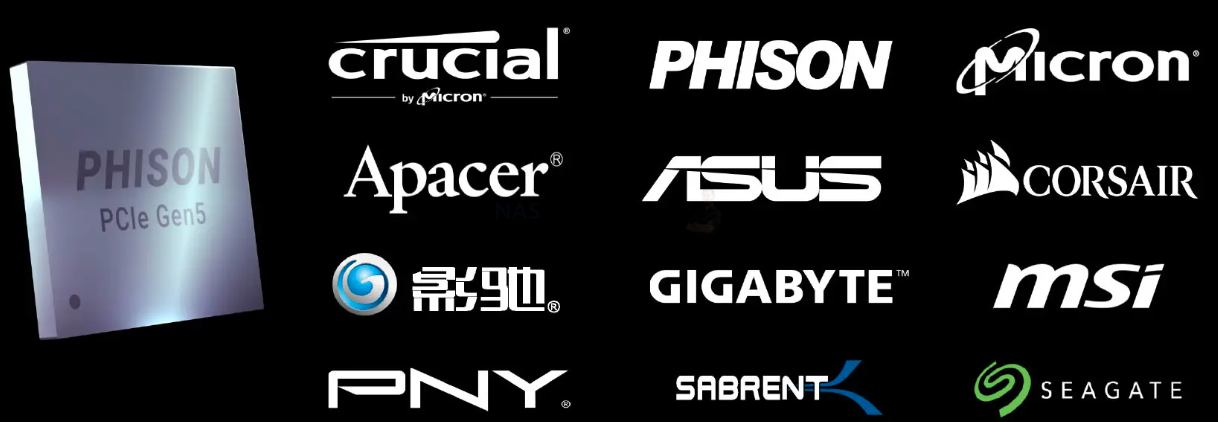
What price to expect
The latest generation of NVMe SSDs, Gen 5, has started to arrive in the market with a price point of around $350 US. Akiba-PC reports that the 2 TB variant with the “CSSD-M2M2TPG5NFZ” id is available in several Japanese outlets for 49,980 Yen, which includes taxes. However, with the removal of taxes, the realistic pricing of the drive should be closer to $385 US. This means that buyers will be paying 13% more than the current fastest PCIe Gen 4.0 NVMe SSD, which is the Samsung 990 Pro priced at $309 US for the 2 TB heatsink variant.
In addition to the price, the CFD Gaming PG5NFZ PCIe Gen 5.0 NVMe SSDs come with features such as Smart Data Processing, Predict & Fetch, and SLC Caching. The heatsink cooler comes equipped with a small 20mm fan and a 45cm cable that connects to a 5V connector. According to CFD Gaming, the active operation is ideal for extreme use cases such as gaming and applications that move a lot of data. However, users who opt for a passive mode will need to ensure good airflow in their PC cases.
Overall, the Gen 5 NVMe SSDs are pushing the boundaries of speed and performance, but the price point may be a deterrent for some buyers. Those who are willing to invest in the latest technology and require extreme performance will benefit from the CFD Gaming PG5NFZ PCIe Gen 5.0 NVMe SSDs with their advanced features and cooling capabilities.
What is available now
The latest generation of NVMe SSDs, Gen 5, has started to arrive in the market with a price point of around $350 US. Akiba-PC reports that the 2 TB variant with the “CSSD–M2M2TPG5NFZ” id is available in several Japanese outlets for 49,980 Yen, which includes taxes. However, with the removal of taxes, the realistic pricing of the drive should be closer to $385 US. This means that buyers will be paying 13% more than the current fastest PCIe Gen 4.0 NVMe SSD, which is the Samsung 990 Pro priced at $309 US for the 2 TB heatsink variant.
In addition to the price, the CFD Gaming PG5NFZ PCIe Gen 5.0 NVMe SSDs come with features such as Smart Data Processing, Predict & Fetch, and SLC Caching. The heatsink cooler comes equipped with a small 20mm fan and a 45cm cable that connects to a 5V connector. According to CFD Gaming, the active operation is ideal for extreme use cases such as gaming and applications that move a lot of data. However, users who opt for a passive mode will need to ensure good airflow in their PC cases.
Overall, the Gen 5 NVMe SSDs are pushing the boundaries of speed and performance, but the price point may be a deterrent for some buyers. Those who are willing to invest in the latest technology and require extreme performance will benefit from the CFD Gaming PG5NFZ PCIe Gen 5.0 NVMe SSDs with their advanced features and cooling capabilities.
https://www.cfd.co.jp/biz/product/release/cssd-m2m4tpg5nfz.html
CFD Gaming has announced its PG5NFZ-series drives, which will be available in 1TB, 2TB, and 4TB configurations, with a PCIe Gen5 x4 interface and a large aluminum heatsink with a small high-speed fan on top. The drives feature Phison’s PS5026-E26 controller paired with Micron’s 3D TLC NAND B58R memory, and are rated to offer up to 10 GBps sequential read speed and up to 9.5 GBps sequential write speed. Random read/write performance can achieve 1.5 million/1.25M million input/output operations per second (IOPS). One of the key selling points of CFD’s PG5NFZ-series drives is their cooling system called Phnix, which incorporates a high-pressure high-speed fan to ensure the best possible cooling for the controller and 3D NAND devices under high loads. The aluminum cooler is 20mm tall (including the bottom cover) and is expected to prolong the lifespan of CFD’s SSDs. The drives are covered with a three-year warranty.
CFD’s PG5NFZ-series drives are notable for their availability timeframe. While other PCIe Gen 5 SSD makers have yet to release a firm release date, CFD says that the 2TB model will be available this November, with other SKUs to follow later. It is noteworthy that PCIe Gen5 SSDs rated for ~12 GBps sequential read speed will likely hit the market only in 2023. The PG5NFZ-series drives also come equipped with a fairly large heatsink to ensure consistent performance under high loads. The cooling system, Phnix, goes above and beyond when it comes to off-the-shelf SSD cooling, and is the first actively-cooled PCIe Gen5 client drive on the market.
One potential issue with CFD Gaming is that the company is a Japan-based retailer that outsources production to third parties, and it is unclear who manufactures the PG5NFZ-series drives. However, Phison provides product development, firmware and hardware customization, as well as manufacturing services to clients, and it is possible that Phison is behind the production of the CFD PG5NFZ drive. While the particular design is probably exclusive to CFD and may never make it outside of Japan, Phison might offer something similar to its other customers, which could lead to actively cooled PS5026-E26-based drives being sold by other suppliers in the U.S. and Europe.
https://www.cfd.co.jp/biz/product/release/cssd-m2m4tpg5nfz.html
▼Sequential Read (Max)
・CSSD-M2M4TPG5NFZ: 10 GB/s → 4TB
・CSSD-M2M2TPG5NFZ: 10 GB/s → 2TB
・CSSD-M2M1TPG5NFZ: 9.5 GB/s → 1TB
▼Sequential Write (Max)
· CSSD-M2M4TPG5NFZ: 9.5 GB/s → 4TB
· CSSD-M2M2TPG5NFZ: 9.5 GB/s → 2TB
· CSSD-M2M1TPG5NFZ: 8.5 GB/s → 1TB 2TB
| JAN | CSSD-M2M4TPG5NFZ: 4988755063388 CSSD-M2M2TPG5NFZ: 4988755063371 CSSD-M2M1TPG5NFZ: 4988755063364 |
||
|---|---|---|---|
| capacity | CSSD-M2M4TPG5NFZ: 4TB CSSD-M2M2TPG5NFZ: 2TB CSSD-M2M1TPG5NFZ: 1TB |
||
| form factor | M.2-2280-D2-M Double Sided M-Key | ||
| interface | PCI Express Gen5 x4 | ||
| protocol | NVMe 2.0 | ||
| cooling | Cooling fan with integrated heat sink (cable length: 45cm, 5V connector) | ||
| controller | Phison PS5026-E26 | ||
| NAND flash | Micron 3D TLC B58R | ||
| cache memory | CSSD-M2M4TPG5NFZ: DDR4 8GB CSSD-M2M2TPG5NFZ: DDR4 4GB CSSD-M2M1TPG5NFZ: DDR4 2GB |
||
| Sequential Read (Max) | CSSD-M2M4TPG5NFZ: 10 GB/s CSSD-M2M2TPG5NFZ: 10 GB/s CSSD-M2M1TPG5NFZ: 9.5 GB/s |
||
| Sequential Write (Max) | CSSD-M2M4TPG5NFZ: 9.5 GB/s CSSD-M2M2TPG5NFZ: 9.5 GB/s CSSD-M2M1TPG5NFZ: 8.5 GB/s |
||
| Random Read (Max) | CSSD-M2M4TPG5NFZ: 1500K IOPS CSSD-M2M2TPG5NFZ: 1500K IOPS CSSD-M2M1TPG5NFZ: 1300K IOPS |
||
| Random Write (Max) | CSSD-M2M4TPG5NFZ: 1250K IOPS CSSD-M2M2TPG5NFZ: 1250K IOPS CSSD-M2M1TPG5NFZ: 1100K IOPS |
||
| TBW | – | ||
| MTBF | – | ||
| Warranty period | 3 years |
As per recent reports, a few Gen 5.0 SSDs have been unveiled, and consumers can expect to see more models in the near future. Some of the models that have already been announced include the Apacer AS2280F5, Corsair MP700, Zadak TWSG5, and Gigabyte AORUS Gen5 10000 SSD. These SSDs are expected to push the boundaries of the new technology straight out of the gate, providing faster data transfer rates and improved overall performance. While there may be some delays in the release of these products, consumers can rest assured that they will soon be able to take advantage of the benefits offered by the latest Gen 5.0 SSDs.
What controller to expect on gen5 WD, Seagate and Samsung M.2 NVMe SSD
Based on the information we have and the latest announcements, it’s likely that we will see the following controllers on Gen5 M.2 NVMe SSDs from WD, Seagate, and Samsung:
- WD: It’s unclear which controller WD will use for their Gen5 SSDs, as they have not yet announced any specific products. However, they have used the Phison E16 controller for their Gen4 SSDs, so it’s possible they will continue to work with Phison for their Gen5 lineup.
- Seagate: Seagate has used Phison in the past. This may allow them to be a first big brand to release their SSD. It’s possible they will continue to use their own controllers for their Gen5 SSDs as well, but it’s not yet confirmed.
- Samsung: Samsung has announced that they will use their own in-house controller for their Gen5 SSDs, the Elpis controller. This controller is expected to deliver significant improvements in speed and power efficiency compared to their Gen4 SSDs.
| Brand | Model | Interface | Capacity | Sequential Read Speed | Sequential Write Speed | Random Read Speed | Random Write Speed | Controller | NAND Flash Type |
|---|---|---|---|---|---|---|---|---|---|
| Seagate | Nytro 3330 | NVMe 1.3 | 1.92TB, 3.84TB, 7.68TB | Up to 3.4 GB/s | Up to 2.2 GB/s | Up to 610,000 IOPS | Up to 135,000 IOPS | Phison PS5012-E12 | Toshiba BiCS3 TLC |
| Seagate | Nytro 3031 | NVMe 1.3 | 960GB, 1.92TB | Up to 3.0 GB/s | Up to 2.0 GB/s | Up to 510,000 IOPS | Up to 90,000 IOPS | Phison E8 | Toshiba BiCS3 TLC |
| Seagate | BarraCuda 510 | NVMe 1.3 | 256GB, 512GB, 1TB, 2TB | Up to 3.5 GB/s | Up to 3.0 GB/s | Up to 345,000 IOPS | Up to 320,000 IOPS | Phison E12 | Toshiba BiCS3 TLC |
| Seagate | BarraCuda 520 | PCIe 4.0 x4 NVMe 1.3 | 500GB, 1TB, 2TB | Up to 5.0 GB/s | Up to 4.4 GB/s | Up to 760,000 IOPS | Up to 700,000 IOPS | Phison E16 | Kioxia BiCS4 TLC |
| Seagate | FireCuda 520 | PCIe 4.0 x4 NVMe 1.3 | 500GB, 1TB, 2TB | Up to 5.0 GB/s | Up to 4.4 GB/s | Up to 760,000 IOPS | Up to 700,000 IOPS | Phison E16 | Kioxia BiCS4 TLC |
| Brand | Model | Interface | Controller | NAND | Max Sequential Read | Max Sequential Write | Max Random Read | Max Random Write | Endurance |
|---|---|---|---|---|---|---|---|---|---|
| WD | WD Red SN700 | PCIe Gen 4 x4 | WD in-house controller | TLC 3D NAND | 7,000 MB/s | 5,300 MB/s | 500K IOPS | 400K IOPS | 600 TBW |
| WD | WD_BLACK SN750 SE | PCIe Gen 4 x4 | WD in-house controller | TLC 3D NAND | 7,000 MB/s | 5,300 MB/s | 1,000K IOPS | 720K IOPS | 1,200 TBW |
| WD | WD_BLACK SN850 | PCIe Gen 4 x4 | WD in-house controller | TLC 3D NAND | 7,000 MB/s | 5,300 MB/s | 1,000K IOPS | 720K IOPS | 1,000 TBW |
| WD | WD_BLACK AN1500 | PCIe Gen 3 x8 | Phison E12 | TLC 3D NAND | 6,500 MB/s | 4,100 MB/s | 750K IOPS | 700K IOPS | 1,200 TBW |
| WD | WD Blue SN550 | PCIe Gen 3 x4 | WD in-house controller | TLC 3D NAND | 2,400 MB/s | 1,950 MB/s | 410K IOPS | 405K IOPS | 600 TBW |
| WD | WD Blue SN570 | PCIe Gen 4 x4 | WD in-house controller | TLC 3D NAND | 4,300 MB/s | 3,800 MB/s | 650K IOPS | 700K IOPS | 1,000 TBW |
| SSD Model | Controller | NAND Flash | Interface | Sequential Read (MB/s) | Sequential Write (MB/s) | Random Read (IOPS) | Random Write (IOPS) |
|---|---|---|---|---|---|---|---|
| Samsung 980 Pro | Samsung Elpis | 3-bit MLC V-NAND | PCIe 4.0 x4 | Up to 7,000 | Up to 5,000 | Up to 1,000,000 | Up to 1,000,000 |
| Samsung 970 EVO Plus | Samsung Phoenix | 3-bit MLC V-NAND | PCIe 3.0 x4 | Up to 3,500 | Up to 3,300 | Up to 600,000 | Up to 550,000 |
| Samsung 970 EVO | Samsung Phoenix | 3-bit MLC V-NAND | PCIe 3.0 x4 | Up to 3,500 | Up to 2,500 | Up to 500,000 | Up to 480,000 |
| Samsung 970 PRO | Samsung Phoenix | 2-bit MLC V-NAND | PCIe 3.0 x4 | Up to 3,500 | Up to 2,700 | Up to 500,000 | Up to 500,000 |
| Samsung 960 EVO | Samsung Polaris | 3-bit MLC V-NAND | PCIe 3.0 x4 | Up to 3,200 | Up to 1,900 | Up to 380,000 | Up to 360,000 |
| Samsung 960 PRO | Samsung Polaris | 2-bit MLC V-NAND | PCIe 3.0 x4 | Up to 3,500 | Up to 2,100 | Up to 440,000 | Up to 360,000 |
People ask about SLC cache. What is it?
Now, some SSDs have a feature called SLC cache. This means that part of the SSD is set aside to work like a really fast storage area. When you write something to the SSD, it’s first written to this fast storage area (SLC cache) and then later moved to the regular, slower storage area of the SSD (TLC).
If you only write a little bit of data, like less than half of the capacity of the SLC cache, everything is fast and great. But if you write more than half of the capacity of the SLC cache, then the SSD has to start moving data directly to the slower part of the SSD, and things slow down.
If you keep writing data until you’ve filled up both the SLC cache and the slower part of the SSD to 90% capacity, then things slow down even more. In fact, the SSD has to work really hard to manage all the data and make sure it’s being written and stored correctly.
So, there are some SSDs that are made to write data to the SLC cache first and then move it to the slower part of the SSD, but only up to a certain point. Once the SLC cache is full, the SSD has to start using the slower part of the SSD to store data directly, and that’s when things slow down.
Different SSDs have different sizes of SLC cache, and some SSDs are made to create more free space when the SSD is not in use, which can help keep things running fast. But in general, the way the SLC cache works can vary from vendor to vendor.
More about NVMe 2.0 controller
NVMe 2.0 is the latest version of the NVMe specification, which defines how solid-state drives (SSDs) communicate with a host system over a PCIe interface. The NVMe 2.0 specification includes various new features, one of which is support for PCIe 5.0, which enables faster data transfer rates and lower latency.
NVMe 2.0 also introduces a new architecture that allows for more efficient use of CPU resources, enabling higher I/O operations per second (IOPS) and lower latency. The new architecture includes a new command set and improved error handling, which can help improve overall reliability and data protection.
One of the key components of an NVMe 2.0 SSD is the controller, which is responsible for managing the data flow between the drive and the host system. The NVMe 2.0 controller typically includes a number of features to improve performance and reliability, such as advanced wear-leveling algorithms, error correction code (ECC), and encryption capabilities.
Overall, NVMe 2.0 represents a significant improvement over the previous version of the specification, offering higher performance and more efficient resource utilization. As such, it is expected to become increasingly prevalent in high-performance computing environments and other applications where speed and reliability are critical.
What about other controllers
Bravera SC5
Marvell, a leading semiconductor company, recently announced the release of the industry’s first PCIe 5.0 SSD controller, the Bravera SC5. This controller delivers a maximum transfer speed of 14GB/s, making it an ideal choice for next-generation data center servers. The company is currently shipping samples of the Bravera SC5 to some customers.
The Bravera SC5 supports 16ch E.1S and achieves more than double the performance of conventional 8ch products. It supports PCI Express 5.0 x4 or x2 x 2 and NVMe 1.4b, enabling a maximum of 14GB/s sequential read, 9GB/s sequential write, 2 million read IOPS, and 1 million write IOPS.
In addition, the Bravera SC5 supports mechanisms that change the behavior of storage devices such as Software-Enabled Flash (SEF), ZNS, and Open Channel. It also supports 5th generation NANDEdge LDPC error correction and the latest QLC/TLC/SLC, which can help increase SSD lifespan and improve power performance ratios.
Moreover, the Bravera SC5 offers FIPS-compliant Root of Trust, AES 256bit encryption, and NAND support of up to 1,600MT/s. Its cache memory is DDR4-3200 or LPDDR4x-4266. The power consumption is less than 8.7W at 8ch and less than 9.8W at 16ch, and the package size is 20 x 20mm.
Overall, the Bravera SC5 is an impressive addition to Marvell’s portfolio of semiconductor products, and its performance and features make it a promising option for next-generation data center servers.
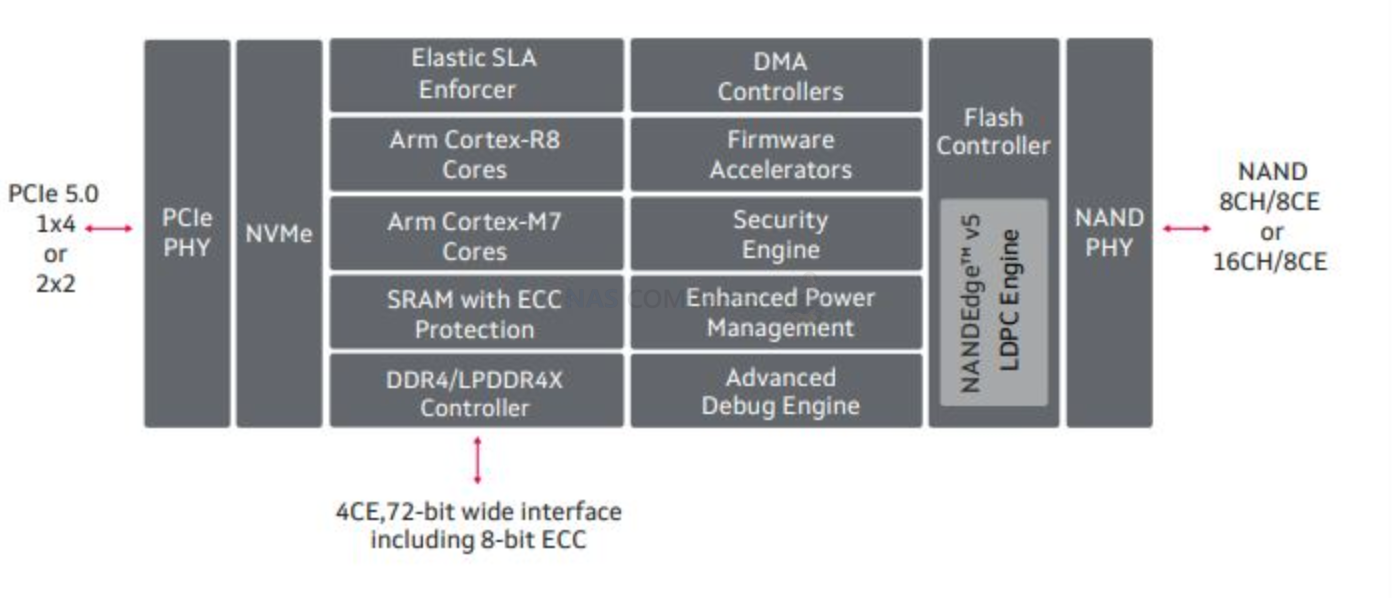
Tell me about Elpis controller
The Elpis controller is a high-performance controller chip used in solid-state drives (SSDs) that was developed by Phison Electronics, a Taiwanese company that specializes in flash memory controller technology. The Elpis controller was first introduced in 2019 and is designed to support the latest NVMe (Non-Volatile Memory express) 1.4 protocol, which offers faster speeds and lower latency than previous versions of NVMe.
The Elpis controller features a quad-core ARM Cortex R5 processor, which provides advanced error correction, wear leveling, and garbage collection capabilities that help to extend the lifespan of the SSD. It also includes a built-in DDR4 DRAM cache, which improves performance by reducing latency and enabling faster data transfers.
Additionally, the Elpis controller offers support for PCIe 4.0, which doubles the bandwidth of PCIe 3.0, allowing for even faster data transfer rates. This makes it ideal for high-performance applications such as gaming, content creation, and data-intensive workloads. The Elpis controller is also designed to be energy-efficient, with a low-power mode that helps to extend battery life in mobile devices.
Will PCIe Gen 5.0 SSDs require thicker heatsinks?
With the advent of PCIe Gen 5.0 technology, which promises even faster data transfer rates than its predecessor, there has been some discussion about whether or not the accompanying solid state drives (SSDs) will require thicker heatsinks. While it is true that PCIe Gen 5.0 SSDs are likely to generate more heat due to the increased speed and data processing capabilities, it is not necessarily the case that thicker heatsinks will be required. Rather, the design and thickness of the heatsink will depend on various factors such as the specific SSD model, the intended usage scenario, and the overall system cooling setup. Ultimately, it will be up to the SSD manufacturers and system builders to determine the most effective cooling solution for PCIe Gen 5.0 SSDs.
Few options out there:
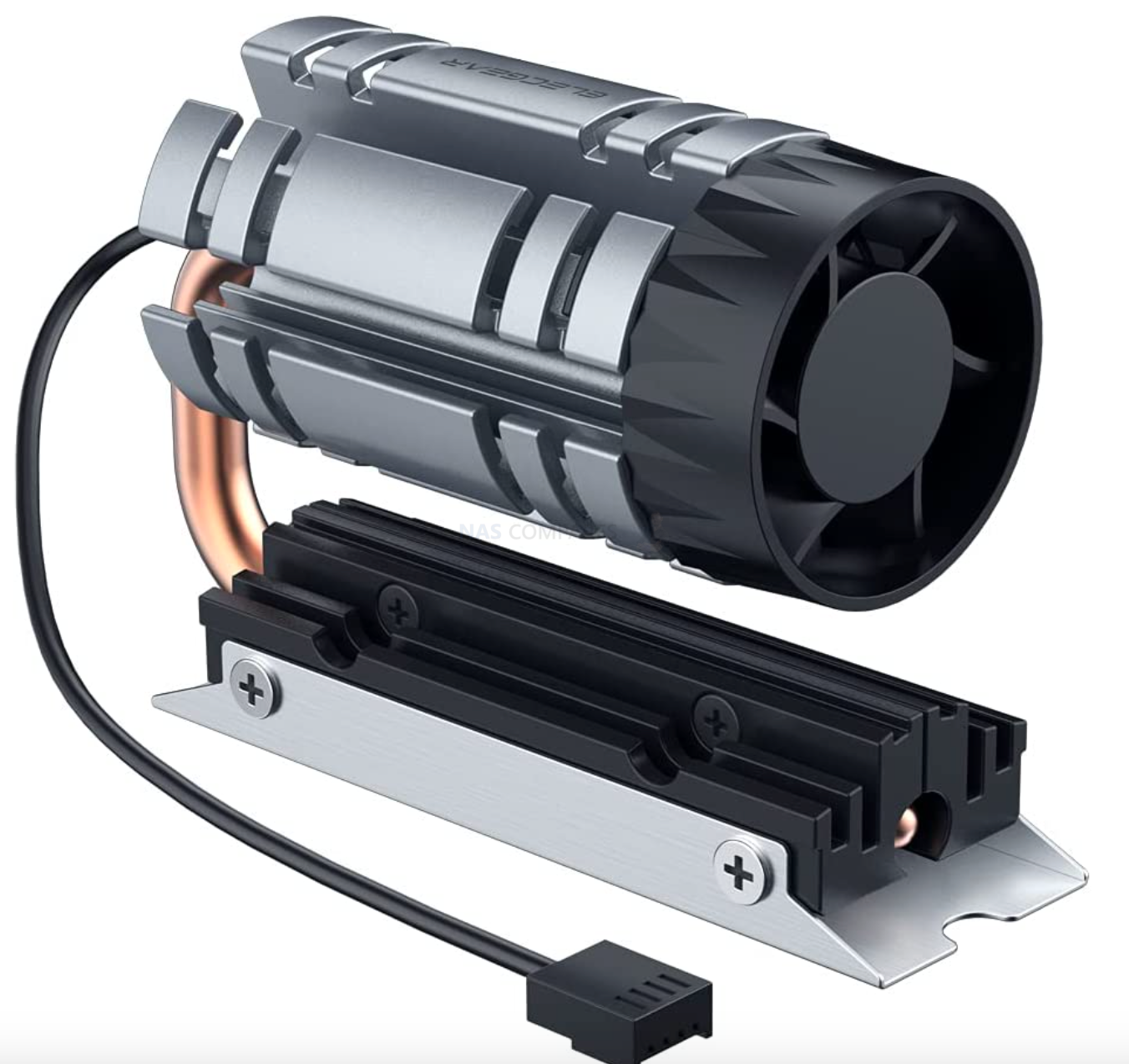
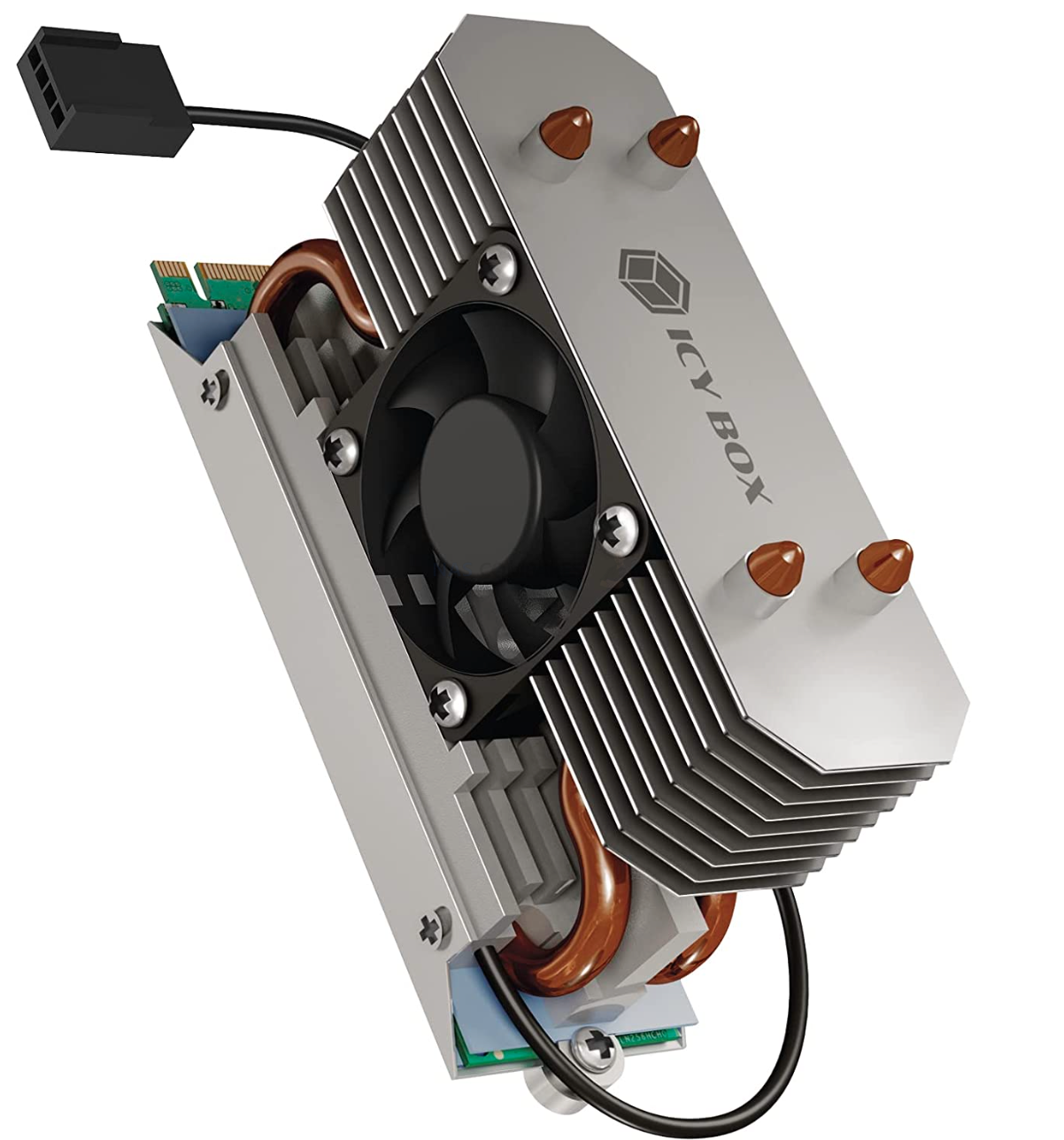
| Where to Buy a Product | |||
|
|
    
|

|
VISIT RETAILER ➤ |
 |
    
|

|
VISIT RETAILER ➤ |
 |
    
|

|
VISIT RETAILER ➤ |
 |
    
|

|
VISIT RETAILER ➤ |
We use affiliate links on the blog allowing NAScompares information and advice service to be free of charge to you. Anything you purchase on the day you click on our links will generate a small commission which is used to run the website. Here is a link for Amazon and B&H. You can also get me a ☕ Ko-fi or old school Paypal. Thanks! To find out more about how to support this advice service check HERE
Beelink ME Pro NAS Revealed
Best SOLID STORAGE NAS of 2025
Should You Worry About the NanoKVM Hidden Microphone?
Best Cheap NAS of 2025
Minisforum MS-02 Ultra - WHO IS THIS FOR??? (The First 48HRs)
Why People Use TrueNAS, UnRAID and Proxmox to Turnkey NAS (Synology, QNAP, etc)
Access content via Patreon or KO-FI
Discover more from NAS Compares
Subscribe to get the latest posts sent to your email.


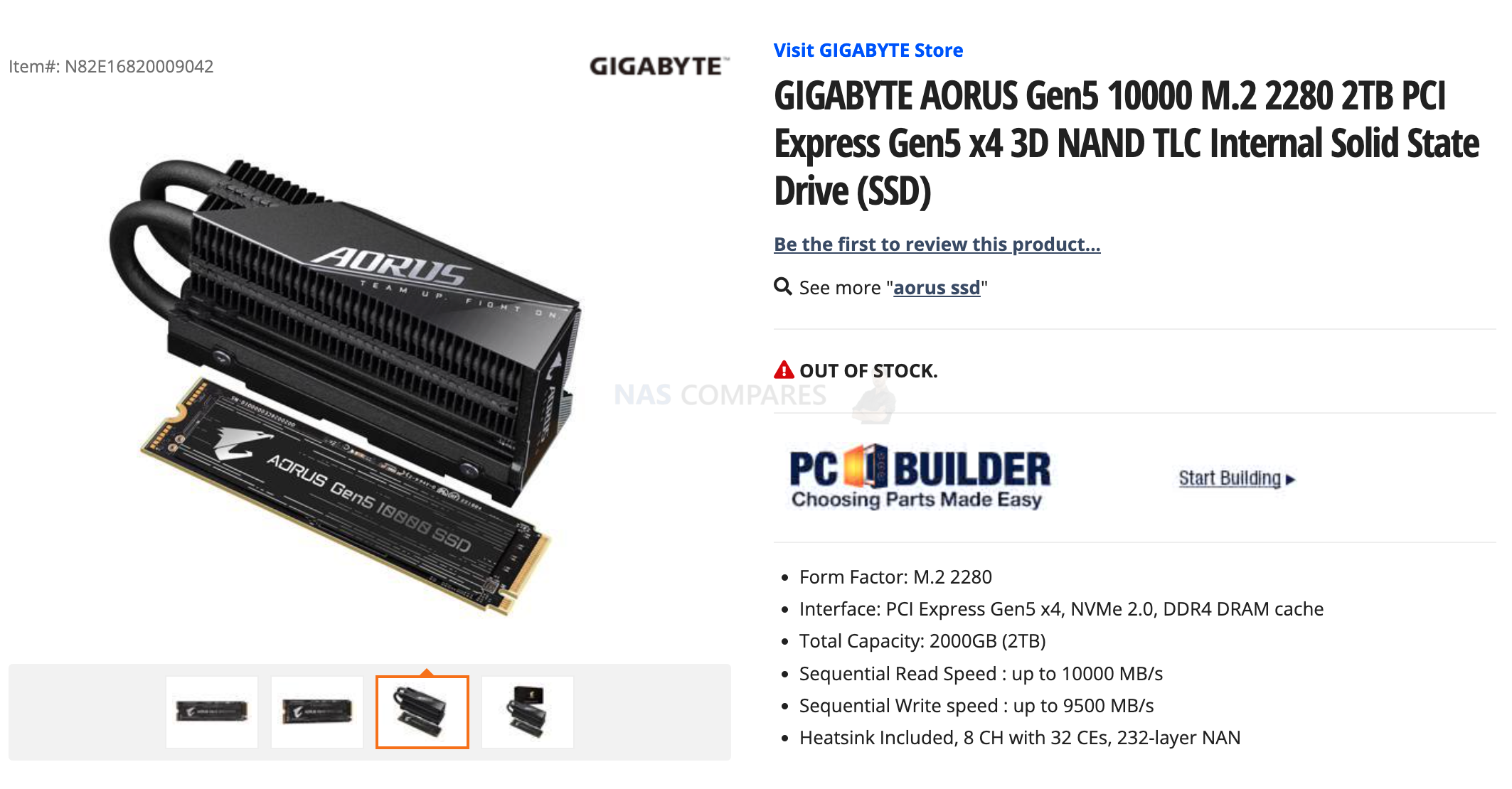
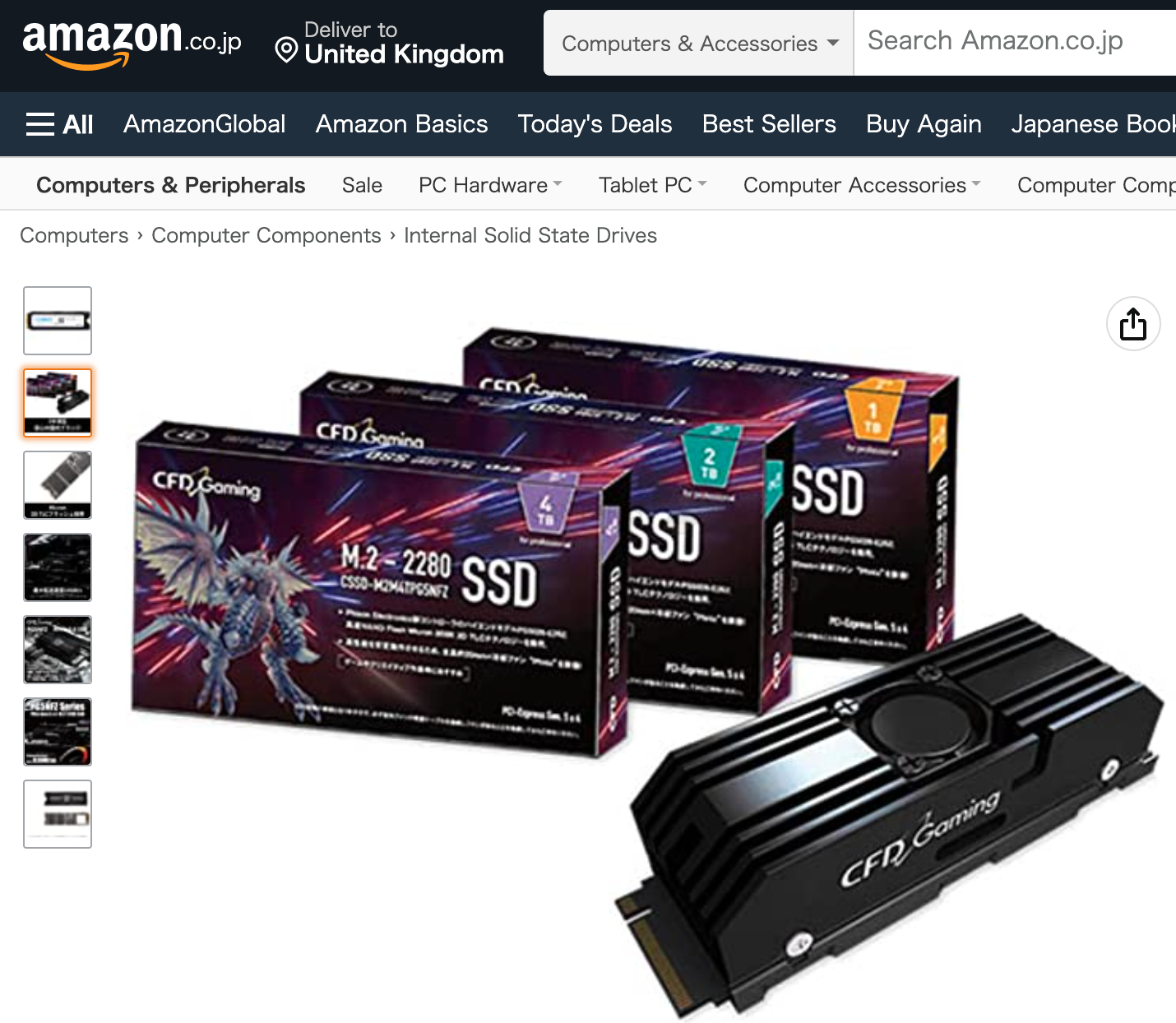



What about Crucial t700 and t705?
REPLY ON YOUTUBE
Will PCIe 5.0 work in PS5?
REPLY ON YOUTUBE
Would be nice, also to see how it perform in a PS5 Fat. Should I upgrade my Gen4 to a Gen5? Or is Gen4 the highest possible speed in the PS5 Fat? Cheers Mate! You’re the best on YT!
REPLY ON YOUTUBE
I’m an avid Flight simmer and have been watching several recent videos about PCIE Gen 5 SSDs. I’m wondering if I’ll see a dramatic improvement in Frame rates and overall performance over a gen 4 drive such as the Samsung 990 Pro.
REPLY ON YOUTUBE
What case did you show at the start that had what looked to be 3 drive bays in the front? Is that a PC case or NAS case?
REPLY ON YOUTUBE
Capacity and speed are the metrics that are saturated. Not bandwidth. At least with current systems. Were barely saturating gen3 bandwidth outside of synthetic benchmarks.
At 10000 mBs the largest 4tb nvme spec’d is written through in 6min40sec
Better controllers are welcome but you’ll get the same performance on gen4 link real world use.
REPLY ON YOUTUBE
My concern is with these new Gen 5 SSDs is the large heatsinks. For example if your primary Gen 5 slot lies under under primary GPU PCI-e slot will the height of the heatsink prevent you using such a large m.2 SSD heatsink in that slot. You also failed to mention Corsair in your list.
REPLY ON YOUTUBE
Not switching from my gen 4 firecuda 4tb for my ps5 unless they offer 6 or 8tb support mid gen through the ps5.
REPLY ON YOUTUBE
We need 2gb min then 4 8 and 16gb teasonably priced cards
REPLY ON YOUTUBE
This could be an interesting cooling option for these upcoming heat monsters. https://www.youtube.com/watch?v=YGxTnGEAx3E
REPLY ON YOUTUBE
hello, firstly great work. Can you say what NAS can use the Gen 3, 4 and 5?
Thank you. Best regards
REPLY ON YOUTUBE
I’m excited to see gen 5 and what it can do, particularly form sabrent. They might be my new drive
REPLY ON YOUTUBE
Can manufacturers please start to substantially improve random QD1 performance instead of sequential QD32 read and writes. I know it looks nice on advertisements, but i don’t need it 🙁
REPLY ON YOUTUBE
Thank you for the video, all of your hard work, and information. Any updates with SK Hynix? Their Platinum P41 Gen 4 Has been extremely popular and curious why they haven’t finally made a 4 TB option. I noticed recently ssd prices have been competitive and on sale with some being all time lows. It should be very interesting to see what will happen once all these gen 5 models arrive.
REPLY ON YOUTUBE
Most likely won’t be able to use the majority of the Gen5 in the normal Synology NVMe slots due to those heatsinks. Maybe in the PCIe add on cards? Yes I realize Synology won’t have the Gen5 support for years to come.
REPLY ON YOUTUBE
Most likely won’t be able to use the majority of the Gen5 in the normal Synology NVMe slots due to those heatsinks. Maybe in the PCIe add on cards? Yes I realize Synology won’t have the Gen5 support for years to come.
REPLY ON YOUTUBE
*Note* – I am only including SSDs in this video with confirmed or highly indicated 2023 releases. There are lots of alternative SSDs in the pipeline from Corsair, Mushkin, GoodRAM or CFD – but these are either still too early in development or are splinters of other SSDs. Also, I realised that I missed the Teamgroup T-Force Cardea Z540 SSD. Arriving in 1TB and 2TB, Phison E26 with 232layer 3D TLC NAND, 12GB/s Read and 10GB/s Write (Seq), 1.4/1.5Million 4K Random IOPS and 0.38DWPD. Find out more about it here – https://www.teamgroupinc.com/en/product/cardea-z540
REPLY ON YOUTUBE
*Note* – I am only including SSDs in this video with confirmed or highly indicated 2023 releases. There are lots of alternative SSDs in the pipeline from Corsair, Mushkin, GoodRAM or CFD – but these are either still too early in development or are splinters of other SSDs. Also, I realised that I missed the Teamgroup T-Force Cardea Z540 SSD. Arriving in 1TB and 2TB, Phison E26 with 232layer 3D TLC NAND, 12GB/s Read and 10GB/s Write (Seq), 1.4/1.5Million 4K Random IOPS and 0.38DWPD. Find out more about it here – https://www.teamgroupinc.com/en/product/cardea-z540
REPLY ON YOUTUBE